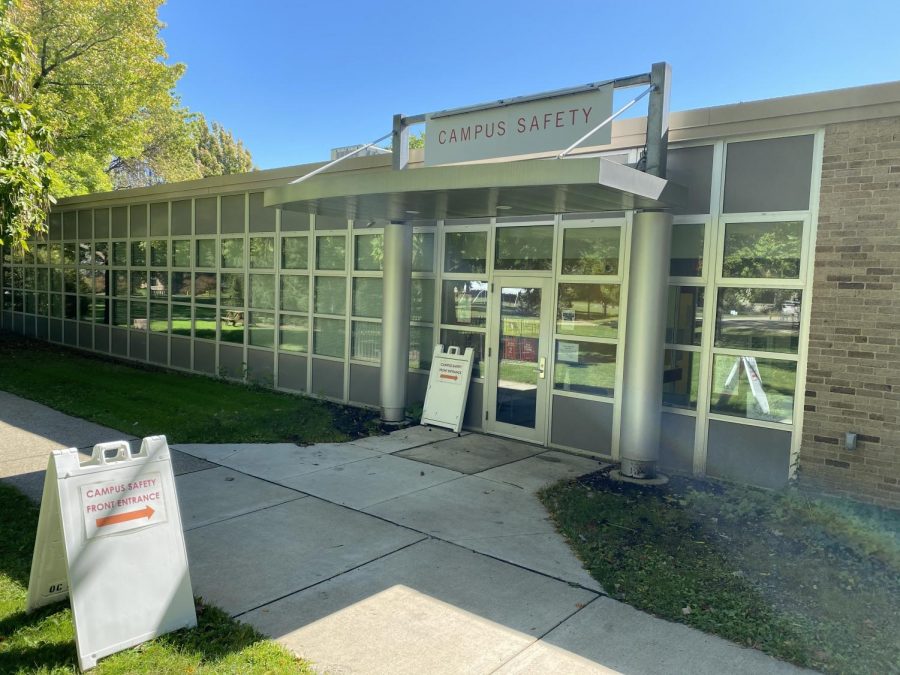Students Call for Peer Intervention for COVID-19 Safety Violations
The Campus Safety Office, which is open 24-hours a day. The Campus Safety department sometimes receives COVID-19 reports of community safety violations to follow up on.
Across the country, many college students are concerned that peer-reports and disciplinary action for noncompliance with COVID-19 safety guidelines could disproportionately impact students of color. At Oberlin, students are calling on one another to reflect on potential biases and consider peer intervention before calling Campus Safety about ObieSafe violations.
Vice President and Dean of Students Meredith Raimondo attests that students of color are not disproportionately represented in Community Agreement non-compliance reports and that her office reviews all reports fairly.
“Staff who work in student conduct are extensively trained in fair process, including how to reflect on and detect unconscious bias,” Raimondo wrote in an email to the Review. “I see no evidence that any particular group on campus has been reported disproportionately for Community Agreement violations.”
In the reports that his department receives, Director of Campus Safety Mike Martinsen maintained that students of color are not disproportionately represented. He is confident that officers on the scene of a noncompliance report treat all students fairly.
“When I came on three years ago, I wanted to assure that our staff understood what the expectations were pertaining to their behavior toward our students,” Martinsen said. “Everyone has to belong on our campus and not be made uncomfortable for any reason. We have zero tolerance toward any form of discrimination or harassment.”
Although Raimondo and Martinsen have not seen evidence of a disproportionate reporting of students of color, some students remain concerned. At the beginning of the semester, College fourth-year Isabel Tadmiri held a small gathering of less than ten people outside of their house. Although participants maintained more than six feet of distance and wore masks, adhering to ObieSafe guidelines, someone reported their gathering to Campus Safety.
“We were playing music, and then [Campus Safety] rolled up and said that someone had taken a video of us and … said that there was a huge party happening against COVID rules,” Tadmiri said. “It was Spanish music and Hindi music, which is, you know, white people maybe aren’t playing that music.”
Tadmiri says that Campus Safety officers confirmed that everyone was adhering to the Community Agreement and told the gathered students that they could carry on.
“In this case, notably as mostly non-Black people of color, we were told to carry on. But it still definitely sucked to know that someone videotaped us, and in a way that clearly was like they didn’t even know what was going on,” Tadmiri wrote in an email to the Review. “Oberlin students have been using Campus Safety when they feel threatened or something (instead of just communicating directly with their peers) since before COVID, namely targeting Black students — so it’s not just a COVID thing, obviously.”
Tadmiri hopes that in the future Oberlin students will consider direct communication and intervention before calling Campus Safety.
“I think people need to remember that there are people who care about COVID and feel unsafe because of COVID and also simultaneously feel unsafe when students try to police other students,” Tadmiri said.
Student Senate has released a statement reflecting some student concerns about how implicit biases can impact students of color in their ObieReal: Policing, Reporting, and Accountability guide.
“While Campus Safety officers are not armed, do not detain people, and in their own words would consider themselves to be ‘educators first’, the effects of policing are felt differently by students of color, and specifically Black students,” Student Senate’s ObieReal statement reads. “If you feel unsafe intervening in a situation, call Campus Safety. If you do not feel unsafe, consider peer-to-peer intervention or completing a non-compliance form.”
Martinsen explained that he is in favor of students practicing peer-to-peer intervention prior to involving Campus Safety.
“Our students are adults,” Martinsen said. “They’re responsible, and I would be very proud of them for being confident enough to address something they perceived to be a threat. Not a serious threat — a serious threat, I would want us to know about it — but something they would perceive to be a threat to our campus community. It goes in line with our bystander training.”
Martinsen also explained how Campus Safety operates differently from a police department.
“We are not an enforcement agency in any way, shape, or form,” Martinsen said. “Our role is to achieve and maintain a safe campus environment for everyone. … We don’t have the formal authority in the state of Ohio to take enforcement action if we observe a violation of the law.”
Martinsen said that Campus Safety works to de-escalate incidents without calling local law enforcement, and prioritizes an education-based and problem-solving approach.
More information about the disciplinary measures for community agreement violations is available here.







